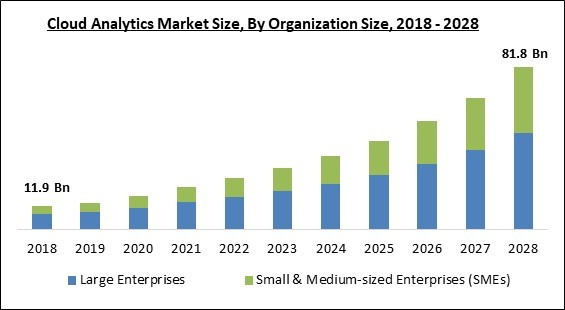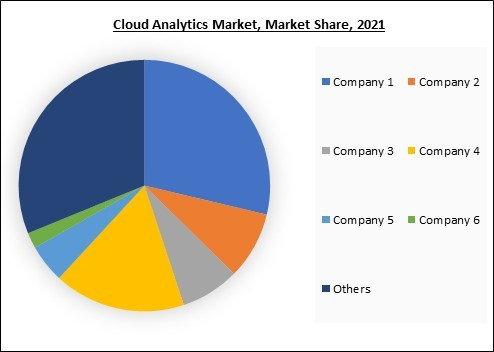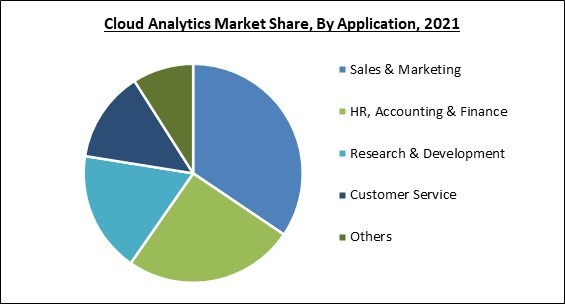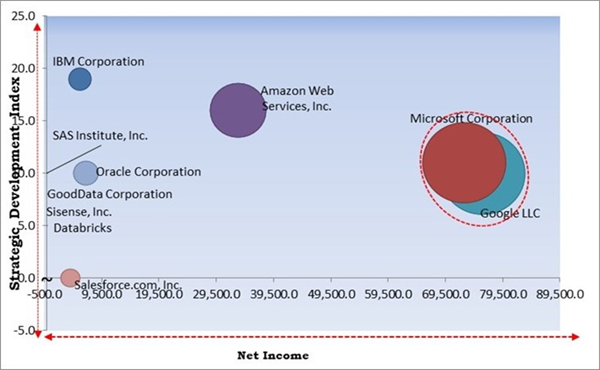The Global Cloud Analytics Market size is expected to reach $81.8 billion by 2028, rising at a market growth of 21.0% CAGR during the forecast period.
Cloud analytics is defined as themethod of storing and analyzing data on the cloud and extracting meaningful business insights from that data. Cloud analytics tools are applied to big data collections for finding patterns, forecast future outcomes, and generate other relevant information for business decision-makers, similar to on-premises data analytics.
With the assistance of cloud analytics, organizations are able to cut operational expenses by avoiding the maintenance and storage costs of on-premises systems, hence reducing IT manpower. In addition, it improves scalability and expansion because it delivers robust capabilities without the necessity to set up or manage servers.
This would lead in freeing up human resources to concentrate on developing company strategies to maximize revenue. Cloud-based analytics solutions provide firms with a solution that connects to many sources of data and automatically updates to provide the most recent results. It provides diverse processing applications to unearth unexpected trends, insights, and novel applications.
In addition, it allows users to effortlessly store and exchange data in order to increase team efficiency and production. The use of cloud analytics services is anticipated to expand throughout the forecast period as a result of the aforementioned advantages offered by cloud analytics to businesses.
The leading players in the market are competing with diverse innovative offerings to remain competitive in the market. The below illustration shows the percentage of revenue shared by some of the leading companies in the market. The leading players of the market are adopting various strategies in order to cater demand coming from the different industries. The key developmental strategies in the market are Partnerships & Collaborations
The major strategies followed by the market participants are Partnerships. Based on the Analysis presented in the Cardinal matrix; Google LLC and Microsoft Corporation are the forerunners in the Cloud Analytics Market. Companies such as Amazon Web Services, Inc., IBM Corporation, Oracle Corporation are some of the key innovators in Cloud Analytics Market.
The market research report covers the analysis of key stake holders of the market. Key companies profiled in the report include Amazon Web Services, Inc., Google LLC, IBM Corporation, Microsoft Corporation, Oracle Corporation, SAS Institute Inc., Sisense, Inc., Salesforce.com, Inc. (Tableau Software, Inc.), GoodData Corporation, and Databricks, Inc.
Cloud analytics is defined as themethod of storing and analyzing data on the cloud and extracting meaningful business insights from that data. Cloud analytics tools are applied to big data collections for finding patterns, forecast future outcomes, and generate other relevant information for business decision-makers, similar to on-premises data analytics.
With the assistance of cloud analytics, organizations are able to cut operational expenses by avoiding the maintenance and storage costs of on-premises systems, hence reducing IT manpower. In addition, it improves scalability and expansion because it delivers robust capabilities without the necessity to set up or manage servers.
This would lead in freeing up human resources to concentrate on developing company strategies to maximize revenue. Cloud-based analytics solutions provide firms with a solution that connects to many sources of data and automatically updates to provide the most recent results. It provides diverse processing applications to unearth unexpected trends, insights, and novel applications.
In addition, it allows users to effortlessly store and exchange data in order to increase team efficiency and production. The use of cloud analytics services is anticipated to expand throughout the forecast period as a result of the aforementioned advantages offered by cloud analytics to businesses.
The leading players in the market are competing with diverse innovative offerings to remain competitive in the market. The below illustration shows the percentage of revenue shared by some of the leading companies in the market. The leading players of the market are adopting various strategies in order to cater demand coming from the different industries. The key developmental strategies in the market are Partnerships & Collaborations
COVID-19 Impact Analysis
During the expansion of COVID-19, businesses have identified the demand for analytical tools that enable data engineers to emphasize data-driven objectives in order to gain insights through the data. On the basis of gathered data, healthcare and pharmacy enterprises use business analysis and other solutions to improve the supply of healthcare aids. Using analytical dashboards, the Center for Disease Control and Prevention (CDC) incorporated cloud analytics tools to improve resource management and drug distribution. In the coming years, it is expected that the cloud analytics market will expand rapidly.Market Growth Factors
Increasing Demand for Bi Tools
As organized and unstructured data have increased in recent times, business intelligence has witnessed popularity. Businesses of all levels are focusing more on integrating business intelligence tools into their business platforms to achieve a competitive edge. Identifying, collecting, storing, and transmitting a vast amount of data in today’s time is a streamlined process utilized by the majority of enterprises. For this intelligence, BI tools are leveraged so that business decisions may be made quickly and easily.Rising Demand For Cloud Analytics Services Across Businesses
Increasing digitization, the availability of a vast array of data, and competitiveness has driven enterprises to implement the tactical decision-making process by focusing on analytics solutions. Businesses are embracing digitization to enhance their business strategies by analyzing vast amounts of unstructured data flowing across several platforms. Estimates suggest that in the coming years the majority of data would be unstructured.Marketing Restraining Factor:
High Dependability on Traditional Data Warehouses
The majority of on-premises and conventional data warehouses utilize a relational or columnar database and SQL to access data. The most significant problem with cloud-based business intelligence is that data warehouses are not fundamentally designed to operate in the cloud. In addition, the optimizations achieved on these data stores, such as sharing, indexing, and compression, do not transition well to the cloud, which is a laterally elastic scale-out infrastructure and not a vertical integration system.Component Outlook
On the basis of component, the cloud analytics market is bifurcated into Solutions and Services. The service segment procured a significant revenue share in the cloud analytics market in 2021. Companies that provide cloud analytics services provide both managed and professional services. The service providers offer data analysis, management, and organization services that help clients make business decisions.Deployment Outlook
Based on deployment, the cloud analytics market is classified into Public, Private and Hybrid. The hybrid segment recorded a substantial revenue share in the cloud analytics market in 2021. Hybrid cloud analytics provides services by integrating the deployment of private and public clouds. A hybrid analytics cloud service enables users to seamlessly migrate assets from private infrastructure possessing on-premises systems to the public cloud in response to variations in process computing needs.Application Outlook
By application, the cloud analytics market is segmented into Sales and Marketing, Research & Development, Customer Service, Accounting & Finance, Human Resource and Others. The human resource and accounting & finance segment witnessed a significant revenue share in the cloud analytics market in 2021. HR analytics software assists human resource professionals in data collection, analysis, and identification of pertinent people metrics.Organization Size Outlook
On the basis of organization size, the cloud analytics market is fragmented into SME and large enterprises. The large enterprise segment witnessed the highest revenue share in the cloud analytics market in 2021. Enterprises are utilizing cloud analytics to boost revenue and discover underperforming and overperforming areas for future business strategy formulation. The data is protected by a password and backed up on systems in multiple locations, resulting in increased security.Industry Vertical Outlook
Based on industry vertical, the cloud analytics market is divided into BFSI, IT & Telecommunication, Retail & Ecommerce, Manufacturing, Healthcare & life sciences, Government, Energy & Utilities and Others. The BFSI segment garnered the largest revenue share in the cloud analytics market in 2021. Growing competition in the BFSI industry has prompted businesses to utilize cloud analytics to enhance the user experience. Using cloud analytics, businesses are enhancing consumer interaction, customer targeting, andcustomer acquisition.Regional Outlook
Region-wise, the cloud analytics market is analyzed across North America, Europe, Asia Pacific and LAMEA. The North America region recorded the maximum revenue share in the cloud analytics market in 2021. The expansion is attributable to the rising adoption of cutting-edge postal technologies and the existence of significant businesses in the region. In addition, rising labor prices and labor shortages are prompting businesses to implement automation, resulting in market expansion.The Cardinal Matrix - Cloud Analytics Market Competition Analysis
The major strategies followed by the market participants are Partnerships. Based on the Analysis presented in the Cardinal matrix; Google LLC and Microsoft Corporation are the forerunners in the Cloud Analytics Market. Companies such as Amazon Web Services, Inc., IBM Corporation, Oracle Corporation are some of the key innovators in Cloud Analytics Market.
The market research report covers the analysis of key stake holders of the market. Key companies profiled in the report include Amazon Web Services, Inc., Google LLC, IBM Corporation, Microsoft Corporation, Oracle Corporation, SAS Institute Inc., Sisense, Inc., Salesforce.com, Inc. (Tableau Software, Inc.), GoodData Corporation, and Databricks, Inc.
Strategies Deployed in Cloud Analytics Market
Partnerships, Collaborations and Agreements:
- Aug-2022: Oracle collaborated with Anaconda, a provider of the world’s most popular data science platform. With this collaboration, Oracle focused on enabling and embedding Anaconda’s repository into Oracle Cloud Infrastructure to provide protected open-source Python and R packages and tools. The collaboration provided data scientists with streamlined access to Anaconda, delivering high-performance machine learning and assisting them to ensure strong enterprise security and governance.
- Aug-2022: Google extended its collaboration with CoreLogic, a leading global property data and analytics-driven solutions provider. Through this collaboration, Google focused on supporting the launch of the CoreLogic Discovery Platform. The platform was built on Google Cloud’s sustainable and secure infrastructure. The collaboration aims to fulfill CoreLogic’s clients’ demands and allows the provision of efficient and comprehensive solutions for enterprises in the real estate finance market.
- Jun-2022: GoodData partnered with Snowflake, a Data Cloud company. With this partnership, GoodData focused on helping customers in unlocking more insights from their data by combining GoodData's direct-query-only, unique, integration with the Snowflake platform. The partnership of GoodData and Snowflake turned knowledge workers across the enterprise into data citizens and aided to generate data-based revenue streams to propel businesses' growth.
- May-2022: Amazon Web Services collaborated with IBM, an American multinational technology corporation. Through this collaboration, AWS aimed to enable IBM to provide a wide range of its software catalog as Software-as-a-Service (SaaS) on AWS. Moreover, the collaboration helped the customers of both companies in enhancing their modernization to the cloud and consuming IBM Services in a cloud-native manner on AWS.
- Feb-2022: Microsoft partnered with Teradata, an intelligent multi-cloud data platform. Following this partnership, the companies combined Microsoft Azure with the Teradata Vantage data platform thus incorporating their cloud and AI capabilities. The partnership helped the companies in serving growing market needs with sustainability, resilience, and efficiency and helped groups across professions and industries to take rapid data-driven decisions.
- Dec-2021: Google Cloud partnered with Kyndryl, an American multinational information technology infrastructure services provider. Following this partnership, the latter company focused on expediting the digital transformation of customers and assisting them in becoming more data-driven, advanced, and sustainable businesses. In this collaboration, Google and Kyndryl applied their expertise in applied AI, analytics, and data, thereby assisting customers in attaining new knowledge and driving business results.
- Nov-2021: AWS collaborated with Goldman Sachs, a multinational investment bank and financial services company. Following this collaboration, the companies focused on creating analytics solutions and new data management for financial services organizations. This collaboration redefines the way clients discover, manage, and analyze data in the cloud, hence enabling them in obtaining rapid insights and draw informed investment decisions.
- Nov-2021: Amazon Web Services partnered with Nasdaq, an American stock exchange based in New York City. Under this partnership, AWS focused on providing the next generation of cloud-enabled infrastructure for the capital markets of the world. Additionally, the partnership provided Nasdaq a way to move its main infrastructure to the cloud and create new services as they advance its second decade of cloud adoption.
- Nov-2021: Amazon Web Services collaborated with Teradata, a connected multi-cloud data platform for business analytics. With this collaboration, AWS aimed at expediting Teradata’s capabilities to fulfill the demands of the voluminous data workloads and subsequently help customers in utilizing data to modernize and innovate rapidly in the cloud. The collaboration accelerated the benefits and value that Teradata can provide to its customers.
- Oct-2021: SAS collaborated with Red Hat, an American software company. Following this collaboration, Red Hat and SAS enable organizations to utilize analytical capabilities and open hybrid cloud technologies thereby driving business-level intelligence. The collaboration allowed model developers to deploy and build models with consistency and portability across their chosen environments with the help of SAS Viya on Red Hat OpenShift. This assisted in expediting the implementation of analytics across the hybrid cloud.
- Mar-2021: Google Cloud collaborated with Deloitte, an international professional services network. Following this collaboration, the companies launched a platform for enterprises to assist them in handling cyber threats. This cloud-native platform is called PACE or Predictive Analytics for Cyber in Enterprises tool. The platform utilizes Deloitte's cyber risk quantification and risk management frameworks along with Google Products namely Loker, Chronicle, and BigQuery. PACE enables companies to identify and mitigate cyber threats.
- Feb-2021: Databricks partnered with Google Cloud, a suite of cloud computing services offered by Google. Following this partnership, the companies focus on allowing enterprises to use Databricks for creating a lakehouse capable of data science, data engineering, analytics, and machine learning on Google Cloud’s global, elastic, and scalable network. This partnership helped the companies in delivering an open, simplified, unified data platform, supporting all AI use-cases and analytics which empowered the customers to innovate more quickly.
- Jun-2020: Microsoft came into partnership with SAS, a leader in analytics. Through this partnership, the companies focused on moving SAS’industry solutions and analytical products onto the Microsoft Azure platform as the chosen cloud provider for the SAS Cloud. Together the companies help customers across many industries and horizontals to address their most complex and important analytical challenges.
Product Launches and Product Expansions:
- Mar-2022: Microsoft unveiled Azure Health Data Services, a platform for analyzing and managing different kinds of patient data. The launched platform-as-a-service (PaaS) assists enterprises in managing disparate kinds of protected health information (PHI) spanning over multiple data stores and allowing them to work with -- and gather insights from -- patient data utilizing fewer resources and time.
- Nov-2021: Oracle introduced Oracle Cloud Infrastructure (OCI) AI services. OCI is a collection of services that make it simpler for developers to implement AI services in their applications without the need for data science expertise. The OCI AI services provide developers the option of leveraging out-of-the-box models, pretrained on business-oriented data, or customized training of services based on the organization’s data.
- Apr-2021: IBM launched new capabilities for IBM Watson for assisting businesses in building trustworthy AI. The capabilities increased Watson tools developed to aid businesses to explain and govern AI-led decisions, rise insight accuracy, remediate risks, and cater to their compliance and privacy demands.
- Apr-2021: GoodData introduced GoodData Cloud Native, a cloud-native analytics platform. This is the first step for the company in the DaaS category introduction. The platform offers certain benefits including a developer-friendly framework, deployment flexibility, and compliance and security. The company released the Community Edition which offers all developers the possibility to evaluate, deploy, and test the GoodData platform free of cost.
- Mar-2021: GoodData launched GoodData insurance solutions on the company's industry-leading cloud analytics platform. Insurance solutions have been developed for improving insurance processes like claims management, underwriting, and customer acquisition. With the insurance solutions of GoodData, insurers could dramatically enhance operational efficiency while obtaining quicker delivery of insights for the users of business.
- Feb-2021: Sisense unveiled Sisense Fusion which aids organizations in infusing analytics everywhere, whether to offer more importance to their customers and reorganize their business or develop innovations and products. Sisense Fusion helps in enhancing every decision and strengthens both employees and customers by offering actionable intelligence.
Acquisition and Mergers:
- Jul-2022: IBM acquired Databand, an Israel-based data observability software provider. Through this acquisition, IBM provides a wide range of observability abilities for IT across data, applications, and machine learning.
- Jun-2022: Oracle Corporation acquired Cerner Corporation, an American supplier of health information technology services, devices, and hardware. Through this acquisition, Oracle focused on expanding its corporate mission to take over the responsibility of overworked medical practitioners and professionals with the new version of easier-to-use digital tools that allow access to information and insights through a hands-free voice interface to protected cloud applications. The newer medical information systems aim to minimize the administrative workload of medical professionals, improve patient outcomes and privacy, and reduce overall costs of healthcare.
- Jun-2022: SAS took over Kamakura Corporation, a provider of specialized data, software, and consulting services to evaluate financial risks. With this acquisition, SAS focused on advancing risk solutions capable of changing the market to solve the most important challenges faced by the financial service customers of the company.
- Mar-2022: Microsoft took over Nuance Communications, a leader in ambient intelligence and conversational AI across sectors. Under this acquisition, Microsoft aimed to bring together the company's secure and reliable industry cloud offerings with Nuance’s best-in-class ambient intelligence and conversational AI. The combination achieved through the acquisition helped providers to offer more effective, affordable, and accessible healthcare. It also assisted organizations in every industry to create more meaningful and personalized customer experiences.
- Jan-2022: Oracle took over Federos, a leading provider of cloud-enabled, AI-optimized network assurance, analytics, and automation software. With this acquisition, Oracle focused on empowering service providers with AI-optimized service and network analytics, assurance, and automated orchestration.
- Oct-2021: Databricks took over 8080 Labs, a cutting-edge German startup. Through this acquisition, Databricks aimed to expedite the accessibility and adoption of lakehouse as the data architecture in the coming future. This acquisition increased the range of the company's user base to a broader audience that opts for low-code/no-code solutions.
- Jul-2021: IBM took over Bluetab Solutions Group, an IT consulting and services firm. With this acquisition, IBM focused on widening its portfolio of data and hybrid cloud consulting services. The acquisition propelled customers' cloud migration and aided them in realizing the importance of the cloud through their mission-critical data.
- Jun-2021: IBM took over Turbonomic, an Application Resource Management (ARM) and Network Performance Management (NPM) software provider. The acquisition made IBM a one-stop vendor of AI-powered automation abilities.
- Jun-2021: AWS acquired Wickr, an encrypted messaging platform used by enterprises and government agencies. Through this acquisition, AWS provided its partners and customers with secure communications solutions thereby assisting government organizations and enterprises to adapt to this transformation in their workforces.
- Mar-2021: AWS took over Perpule, a retail tech startup. With this acquisition, AWS focused on offering opportunities to businesses of all sizes in India by offering Perpule's innovative cloud-based POS services that allow Indian offline stores to efficiently manage their checkout processes, inventory, and overall customer experience. This simultaneously raised the standard of shopping experience for customers of the region.
- Jan-2021: SAS acquired Boemska, a technology company specializing in low-code/no-code application deployment and management of analytic workload. Through this acquisition, SAS aimed to enhance the SAS Viya, advanced analytics, a cloud-native platform with a lucrative set of abilities that propel SAS’ goal of augmenting the life cycle of entire analytics thereby facilitating the migration of customers to the cloud.
- Dec-2020: IBM acquired Instana, leading enterprise observability and application performance monitoring platform. Through this acquisition, IBM focused on offering industry-leading, AI-powered automation abilities to mitigate the complexities of modern applications spanning over hybrid cloud landscapes. The acquisition provided clients with a leading enterprise observability platform to guide automated remediation strengthened by contextualized data with profiles, traces, metrics, and dependency mapping from Instana.
- Feb-2020: Google Cloud acquired Looker, a data analytics company. With this acquisition, the company aimed to address the business intelligence and data analytics demands globally across various industries. The acquisition of Looker fortified Google Cloud’s data warehouse and analytics abilities, including BigQuery thereby allowing customers to mitigate their hardest business challenges rapidly while retaining full control of data.
Scope of the Study
By Organization Size
- Large Enterprises
- Small & Medium-sized Enterprises (SMEs)
By Application
- Sales & Marketing
- HR, Accounting & Finance
- Research & Development
- Customer Service
- Others
By Deployment
- Public
- Private
- Hybrid
By Component
- Solution
- Services
By Vertical
- BFSI
- IT & Telecommunication
- Retail & Ecommerce
- Government
- Healthcare & Life Sciences
- Energy & Utilities
- Manufacturing
- Others
By Geography
- North America
- US
- Canada
- Mexico
- Rest of North America
- Europe
- Germany
- UK
- France
- Russia
- Spain
- Italy
- Rest of Europe
- Asia Pacific
- China
- Japan
- India
- South Korea
- Singapore
- Malaysia
- Rest of Asia Pacific
- LAMEA
- Brazil
- Argentina
- UAE
- Saudi Arabia
- South Africa
- Nigeria
- Rest of LAMEA
Key Market Players
List of Companies Profiled in the Report:
- Amazon Web Services, Inc.
- Google LLC
- IBM Corporation
- Microsoft Corporation
- Oracle Corporation
- SAS Institute Inc.
- Sisense, Inc.
- Salesforce.com, Inc. (Tableau Software, Inc.)
- GoodData Corporation
- Databricks, Inc.
Unique Offerings
- Exhaustive coverage
- The highest number of market tables and figures
- Subscription-based model available
- Guaranteed best price
- Assured post sales research support with 10% customization free
Table of Contents
Chapter 1. Market Scope & Methodology
Chapter 2. Market Overview
Chapter 3. Competition Analysis - Global
Chapter 4. Global Cloud Analytics Market by Organization Size
Chapter 5. Global Cloud Analytics Market by Application
Chapter 6. Global Cloud Analytics Market by Deployment
Chapter 7. Global Cloud Analytics Market by Component
Chapter 8. Global Cloud Analytics Market by Vertical
Chapter 9. Global Cloud Analytics Market by Region
Chapter 10. Company Profiles
Companies Mentioned
- Amazon Web Services, Inc.
- Google LLC
- IBM Corporation
- Microsoft Corporation
- Oracle Corporation
- SAS Institute Inc.
- Sisense, Inc.
- Salesforce.com, Inc. (Tableau Software, Inc.)
- GoodData Corporation
- Databricks, Inc.
Methodology

LOADING...
Table Information
| Report Attribute | Details |
|---|---|
| No. of Pages | 348 |
| Published | October 2022 |
| Forecast Period | 2021 - 2028 |
| Estimated Market Value ( USD | $ 21359.7 Million |
| Forecasted Market Value ( USD | $ 81844 Million |
| Compound Annual Growth Rate | 21.0% |
| Regions Covered | Global |
| No. of Companies Mentioned | 10 |












